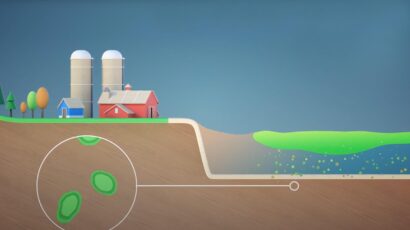Why is P a Problem?
When there is too much phosphorus in a lake or pond, it can cause excess growth of plants, algae, and microscopic cyanobacteria. This can choke waterways with vegetation and impact the health of human, pets, and wildlife.
Phosphorus is key element in the formation of cyanobacteria blooms on the water surface. These blooms can sometimes be toxic to humans and animals, and so can trigger health advisories and close beaches during the summer.
Cyanobacteria blooms often appear as a blue-green sheen on the water surface, resembling a thick pea soup or a paint slick. For this reason, they are sometimes incorrectly referred to as blue-green algae.
People can be exposed to toxins produced by cyanobacteria through direct skin contact, breathing them in, or swallowing them. Exposure can cause conditions ranging from a mild skin rash to serious illness or in rare circumstances, death. Short-term exposure during recreational activities can result in hay fever-like symptoms, skin rashes, and respiratory and gastrointestinal distress. Exposure to drinking water contaminated with elevated levels of certain toxins could cause liver and kidney damage.

Cyanobacteria Are a Natural Part of Ecosystems.
They are the oldest life-forms on Earth. Fossils show they have been here for 3.5 billion years! They were critical to the evolution of life on Earth because they were the first organisms to produce oxygen through photosynthesis.




